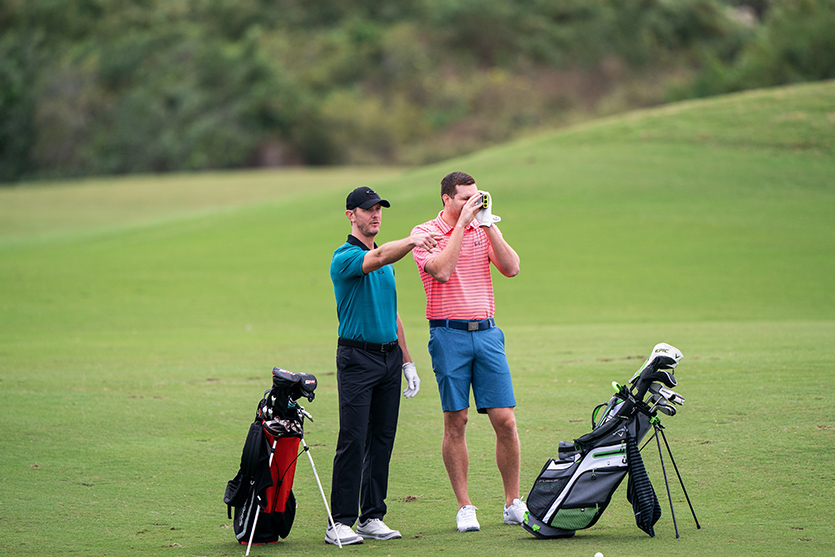How Do Golf Rangefinders Work

Golf rangefinders have become increasingly popular among golfers looking to improve their game. These devices use laser or GPS technology to provide accurate distance measurements to the pin or hazards on the course, allowing golfers to make more informed decisions and execute better shots. But have you ever wondered how these devices actually work?
In this article, we’ll explore the intricacies of golf rangefinders and how they can help golfers of all skill levels improve their game. We’ll delve into the anatomy of golf rangefinders, including their optical and laser systems, and explain how they work together to provide accurate distance measurements. We’ll also examine the different types of golf rangefinders available, including handheld and wearable devices, and highlight the various features and modes they offer.
But it’s not just about the advantages of using golf rangefinders – we’ll also discuss their limitations and potential drawbacks, such as the impact of weather conditions and restrictions on their use during play. We’ll also provide tips on how to maintain and operate your golf rangefinder safely and effectively.
By the end of this article, you’ll have a thorough understanding of how golf rangefinders work and how they can benefit your golf game. Whether you’re a beginner or an experienced golfer, you’ll be equipped with the knowledge to make informed decisions on the course and improve your overall performance.

The Anatomy of Golf Rangefinders
Golf rangefinders consist of several components that work together to provide accurate distance measurements. The optical system is responsible for capturing and magnifying the image of the target. The laser technology then calculates the distance based on the time it takes for the laser beam to travel to the target and bounce back. The software processes the data and displays the results on the screen.
How Golf Rangefinders Work
To use a golf rangefinder, you simply point it at your target and press a button. The device then emits a laser beam that bounces off the target and returns to the rangefinder. The rangefinder then calculates the distance based on the time it took for the laser beam to travel and return. Some rangefinders also have different modes and features, such as slope adjustment and pin-seeking technology.
There are two main types of golf rangefinders: GPS and laser. GPS rangefinders use satellites to determine your location and provide distance measurements based on pre-loaded course maps. Laser rangefinders, on the other hand, use laser technology to measure distances to specific targets.
While golf rangefinders are generally accurate, there are limitations to their performance. For example, weather conditions, such as rain or fog, can affect the accuracy of laser rangefinders. Additionally, some courses may have restrictions on the use of rangefinders during play.
Types of Golf Rangefinders
There are two main types of golf rangefinders: handheld and wearable. Handheld rangefinders are typically more accurate and versatile, but can be cumbersome to carry around the course. Wearable rangefinders, such as those built into golf watches, offer a more convenient option, but may sacrifice some accuracy and functionality.
There are also different models and features of golf rangefinders, such as slope adjustment and pin-seeking technology. Slope adjustment takes into account the slope of the course and adjusts the distance measurement accordingly. Pin-seeking technology helps to isolate the flagstick and provide more accurate distance measurements to the pin.
Advantages and Disadvantages of Golf Rangefinders
The main advantage of using a golf rangefinder is the ability to accurately measure distances and make more informed decisions. This can lead to better shot execution and ultimately lower scores. However, there are also some drawbacks to using a golf rangefinder. For example, some golfers may become overly reliant on the device and neglect their ability to estimate distances through feel and experience. Additionally, some courses may have restrictions on the use of rangefinders during play.
Maintenance and Safety of Golf Rangefinders
To ensure proper functioning, golf rangefinders should be kept clean and stored in a dry place. It’s also important to follow proper safety guidelines when operating a golf rangefinder, such as avoiding pointing the laser beam directly at someone’s eyes.
Conclusion
Golf rangefinders have become an essential tool for golfers looking to improve their game. By understanding the anatomy and function of these devices, golfers can make more informed decisions and execute better shots on the course. While there are limitations and considerations to using golf rangefinders, their benefits can greatly enhance the golfing experience.






